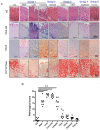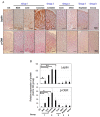Dietary Fat-Accelerating Leptin Signaling Promotes Protumorigenic Gastric Environment in Mice
- PMID: 31489936
- PMCID: PMC6770546
- DOI: 10.3390/nu11092127
Dietary Fat-Accelerating Leptin Signaling Promotes Protumorigenic Gastric Environment in Mice
Abstract
Excess of fat intake leads to obesity and causes a variety of metabolic diseases and cancer. We previously demonstrated that high-lard diet induces intestinal metaplasia, a precancerous lesion of the stomach mediated by leptin signaling. This study aims to investigate which kinds of dietary fat cause the intestinal metaplasia onset. We fed eight kinds of high-fat diets (HFDs) of animal or plant origin to mice evaluated their effect on gastric pathogenesis. Five types of dietary fat were divided according to their observed effects: Obese with high metaplasia (group I; beef tallow, lard, and hydrogenated coconut oil), non-obese with high metaplasia (group II; linseed oil), obese without metaplasia (group III; corn oil and olive oil), non-obese without metaplasia (group IV, soybean oil) and lean without metaplasia (group V; cocoa butter). The group I and II diets induced leptin, phosphorylated leptin receptor (ObR), signal transducer and activator 3 (STAT3), and increased intracellular β-catenin accumulation in the stomach. Moreover, mice fed these HFDs with 1-methyl-3-nitro-1-nitrosoguanidine (MNNG), a gastric carcinogen, and further accelerated dysplasia in the stomach. Lactobacillus occupancy in the stomach increased in all HFDs except hydrogenated coconut oil. Our findings suggest that HFDs inducing leptin signaling accelerate the enhancement of protumorigenic gastric microenvironment independent of body mass gain or microbiome changes.
Keywords: high-fat; leptin; microbiota; protumorigenesis; stomach.
Conflict of interest statement
The authors declare no conflict of interest.
Figures








Similar articles
-
High-fat-diet-induced modulations of leptin signaling and gastric microbiota drive precancerous lesions in the stomach.Nutrition. 2019 Nov-Dec;67-68:110556. doi: 10.1016/j.nut.2019.110556. Epub 2019 Jul 23. Nutrition. 2019. PMID: 31554603
-
High-fat diet feeding promotes stemness and precancerous changes in murine gastric mucosa mediated by leptin receptor signaling pathway.Arch Biochem Biophys. 2016 Nov 15;610:16-24. doi: 10.1016/j.abb.2016.09.015. Epub 2016 Sep 28. Arch Biochem Biophys. 2016. PMID: 27693038
-
Differential effects of fish-oil and cocoa-butter based high-fat/high-sucrose diets on endocrine pancreas morphology and function in mice.Front Endocrinol (Lausanne). 2024 Feb 13;15:1265799. doi: 10.3389/fendo.2024.1265799. eCollection 2024. Front Endocrinol (Lausanne). 2024. PMID: 38414818 Free PMC article.
-
Gastric Leptin and Tumorigenesis: Beyond Obesity.Int J Mol Sci. 2019 May 28;20(11):2622. doi: 10.3390/ijms20112622. Int J Mol Sci. 2019. PMID: 31141984 Free PMC article. Review.
-
Dietary fat and colon cancer: animal model studies.Lipids. 1992 Oct;27(10):807-13. doi: 10.1007/BF02535855. Lipids. 1992. PMID: 1435100 Review.
Cited by
-
Microbiota and gastric cancer: from molecular mechanisms to therapeutic strategies.Front Cell Infect Microbiol. 2025 Jun 3;15:1563061. doi: 10.3389/fcimb.2025.1563061. eCollection 2025. Front Cell Infect Microbiol. 2025. PMID: 40529304 Free PMC article. Review.
-
The mediating role of caffeine and biological age in the association between dietary index for gut microbiota and osteoporosis.Front Nutr. 2025 Jun 13;12:1559674. doi: 10.3389/fnut.2025.1559674. eCollection 2025. Front Nutr. 2025. PMID: 40584094 Free PMC article.
-
Effect of Dietary Modification on Gastric Mucosa, Gastrointestinal Symptoms and Nutritional Status of Patients With Early Gastric Cancer After Endoscopic Submucosal Dissection Surgery: A Retrospective Cohort Study.Front Nutr. 2022 Mar 22;9:741630. doi: 10.3389/fnut.2022.741630. eCollection 2022. Front Nutr. 2022. PMID: 35399675 Free PMC article.
-
A Dynamic Transcriptome Map of Different Tissue Microenvironment Cells Identified During Gastric Cancer Development Using Single-Cell RNA Sequencing.Front Immunol. 2021 Oct 21;12:728169. doi: 10.3389/fimmu.2021.728169. eCollection 2021. Front Immunol. 2021. PMID: 34745098 Free PMC article.
-
Implications of Gut Microbiota in Epithelial-Mesenchymal Transition and Cancer Progression: A Concise Review.Cancers (Basel). 2022 Jun 16;14(12):2964. doi: 10.3390/cancers14122964. Cancers (Basel). 2022. PMID: 35740629 Free PMC article. Review.
References
MeSH terms
Substances
Grants and funding
LinkOut - more resources
Full Text Sources
Medical
Miscellaneous

